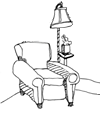Firm
computer modeling

DMA uses the most up-to-date two- and three-dimensional CAD programs to produce computer-generated images of our projects. We can create elevations, interior and exterior perspectives, and animated computer-generated videos that depict walk-through, drive-by and fly-by images of a building. Computer-generated images provide a sneak preview of the spaces within a building, the overall effect of a project, and a chance to experiment with various material palettes.
interior + furniture design

At DMA, the importance of interior design in a properly conceived building is viewed as co-equal with architectural design. DMA's interior design process is one that is structured to provide cost-effective interior furnishings that are seamlessly integrated with the architecture, creating a unified, cohesive setting. We show our clients a range of choices for materials, furnishings, and signage each selected or custom-designed for their compatibility with the architectural character of the particular building. We concern ourselves with finding the most functional layouts and development of the smallest details of each and every work station, including wire management and proper illumination, as well as the ergonomic and accessibility considerations. Clients are sometimes surprised to learn that many of the appropriate items of furniture for their building are not warehoused somewhere but are actually built for their specific project when needed. In larger projects, this fact allows a client to have some items of furniture custom-designed to reflect aspects of the building's design. DMA staff members have provided custom designed furniture and service desks for many of the firm's public libraries.
historic preservation

David Milling and the staff members at DMA have successfully completed numerous renovations and additions of cherished historic buildings. DMA will address issues such as lack of barrier-free access, faulty plumbing, inadequate lighting, climate control, and technology for modern building functions -- while simultaneously respecting the architecture of the original structure and restoring the building to its original intentions.
lighting design

DMA recognizes the powerful positive effect that properly-conceived lighting has on people and their feelings about the activities in which they are engaged. Accordingly we work closely with qualified lighting consultants to achieve special satisfying results with lighting and, occasionally, DMA staff members actually design lighting fixtures as we did for several Kalamazoo Public Library projects.
models + Drawings

DMA can produce three-dimensional physical models of conceptual alternatives, as well as final models for public display and fund-raising activities. DMA produces a variety of presentation materials in the form of large-scale color plans and elevations, perspective sketches, and diagrams. These images usually show conceptual alternatives or final designs, and are suitable for review by public agencies, for use as a fund-raising tool, as well as for generating public excitement about an upcoming project.
site selection

DMA can provide a written Site Viability Analysis, documenting alternative sites identified and the recommended ranking of each, based on comparative evaluations. Only the most viable will be recommended for engineering tests and surveys. If appropriate, we will facilitate a workshop where all in attendance are encouraged to participate in a discussion of the options under consideration. Clients frequently choose for this to be a well-publicized event for all interested citizens. At this forum, any site can be nominated, and each will be addressed systematically, utilizing established site-selection criteria for the proposed building.
master planning

DMA provides Master Planning services for clients who have sites that require the planning of infrastructure and facilities that will be built over time. With a masters degree in Urban Design and Planning from MIT, David Milling personally provides leadership for DMAs Site Planning and Master Planning services.
strategic planning

DMA can provide assistance with the development of a long-range facilities plan, with a focus on the integration of technology and architecture. If appropriate, DMA can provide the Owner with a public relations strategy, advice during the architect-selection process, and help with structuring a team and set of procedures for obtaining a Needs Assessment document.
programming

DMA can prepare a document summarizing square-footage requirements and special attributes needed to accommodate a variety of activities planned in new and/or renovated facilities.
project phasing

In some cases, such as renovations and addition projects in particular, there is a need to carefully phase the construction so that some portions of a building remain occupied while other portions are negatively affected by construction activities. DMA works with clients to ensure that disruptions of this nature are minimized and that all who will be affected have a realistic understanding of the disruptions that will occur.
facility assessment

DMA can prepare a document summarizing the opportunities and constraints associated with existing facilities: the physical conditions of an existing building, its engineering systems, and the expansion options in all practical directions.
needs assessment

DMA provides detailed analyses of a client's needs for facilities. For non-residential projects, these analyses frequently include a profile of the population being served, including demographics and projections for twenty-years of growth as compared with other institutions of comparable size, mission, service population, and funding. We provide alternative scenarios so that clients can choose from projections that utilize facilities intensely (minimum square footage allocations) to those that allow more generous allocations of space for each activity. A properly conceived Needs Assessment is the first step toward generating an appropriate Building Programming Statement.
budgeting

We are committed to developing a proper budget and then apportioning the construction cost to each engineering discipline at the earliest possible time in the design process. From this cost model, we will develop a scope of work for each discipline. All members of the design team must be made aware of their individual portion of the project's scope, and they must take responsibility for meeting their portion of the budget.
Construction observation

During the Construction Phase, DMA works with the Owner's representatives, the Builder, and subcontractors to ensure the quality and timely completion of the building. We visit the site on a regular basis, observing that the construction is progressing in accordance with the construction documents. We provide written reports regarding each site visit to ensure that the Owner and Builder are properly informed of the status of the work. We work with the Builders and sub-contractors on a daily basis to answer any questions that may arise during the construction process. We conduct monthly Owner/Architect/Builder meetings to review the progress of the work-in-place and to discuss the work to be done in the next thirty days. At the time when a project is nearing completion, we conduct an exhaustive inspection of the work to determine if the project is substantially complete, and we develop a punch-list of items to be corrected or completed by the Builder prior to approval of final payment.
code + ordinace work

ADA standards are derived from common sense considerations pertaining to buildings, but successful implementation requires experience. The staff members of DMA have been designing public buildings in compliance with ADA standards, as well as the more stringent Michigan Barrier-Free Code, since 1990.